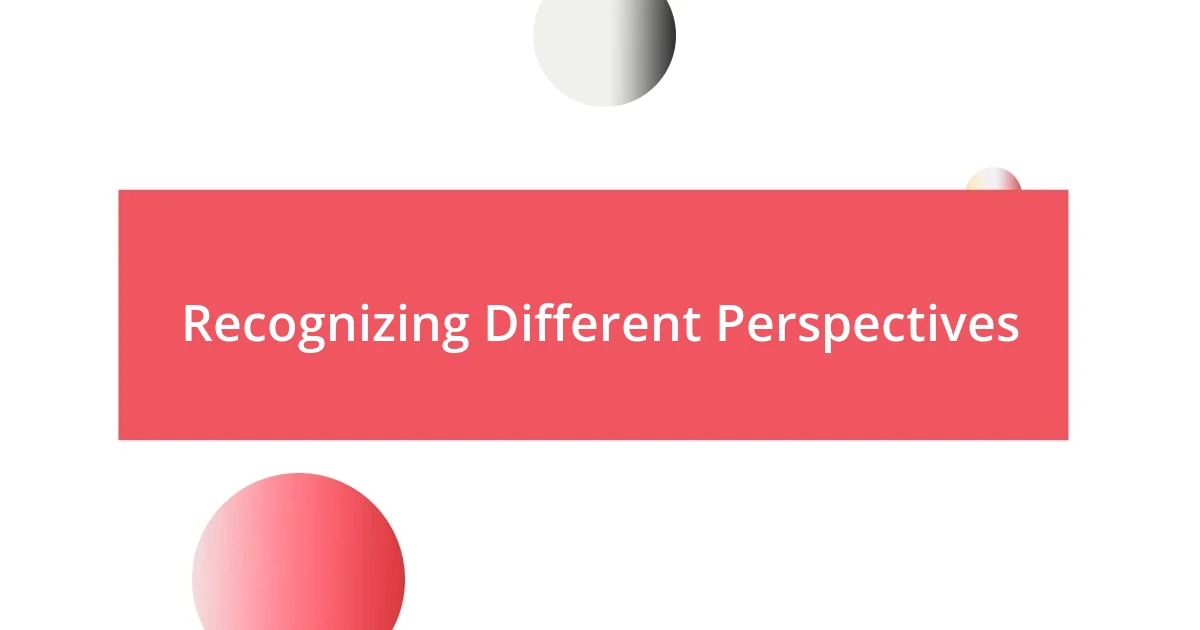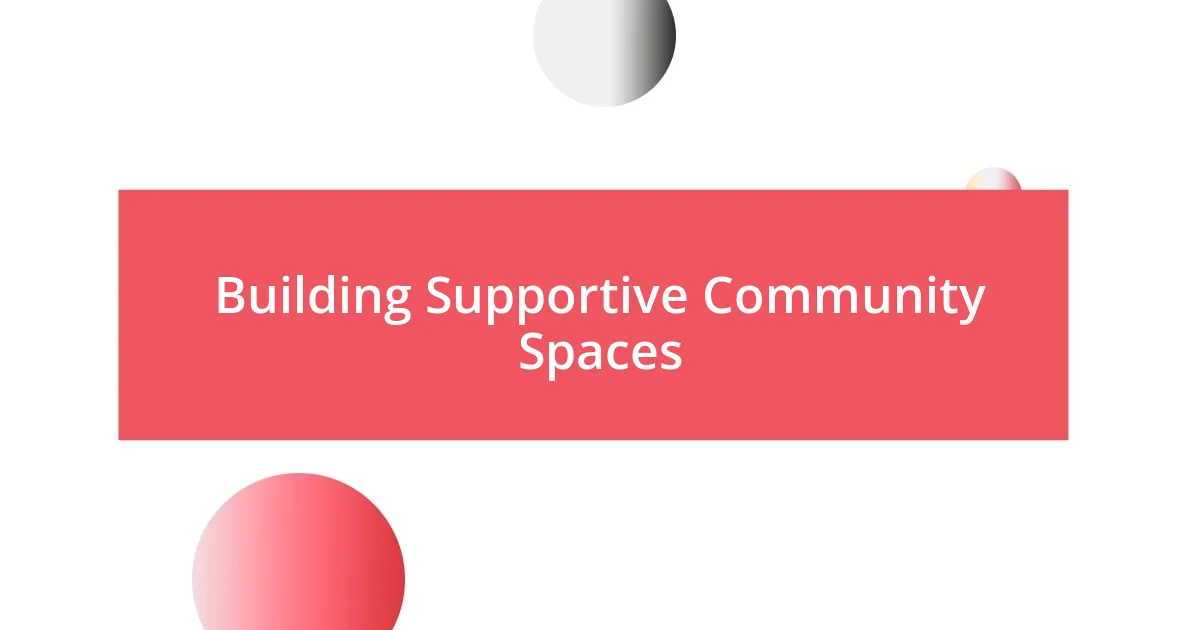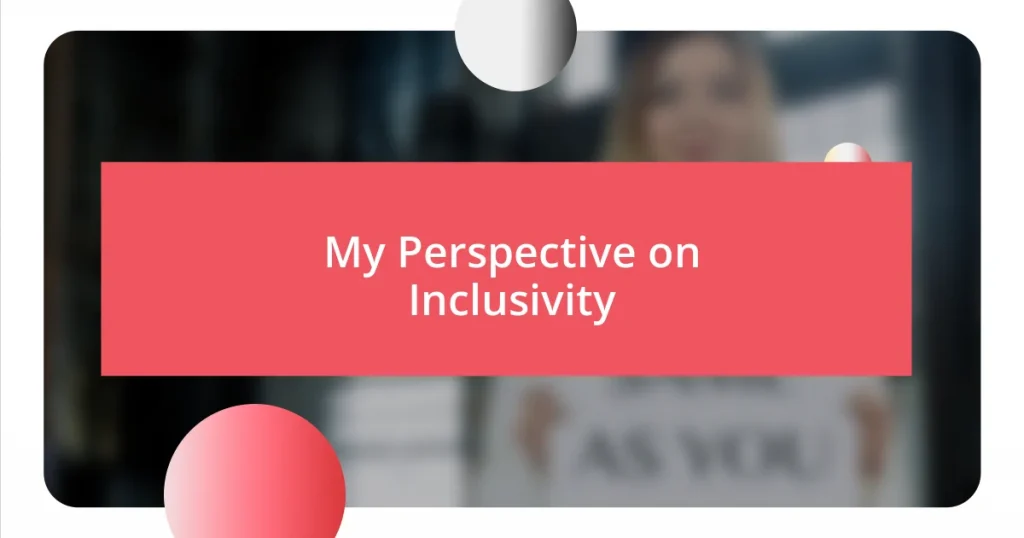Key takeaways:
- Inclusivity enhances innovation and collaboration, leading to higher employee satisfaction and stronger community bonds through diverse perspectives.
- Creating inclusive environments involves intentional physical arrangements, active participation from all members, and involving diverse voices in decision-making.
- Measuring inclusivity effects through engagement tracking and personal storytelling provides valuable insights and fosters a deeper understanding of community needs.

Understanding Inclusivity Benefits
Inclusivity brings a wealth of benefits that go beyond mere compliance with social expectations. From my experience in diverse team settings, I’ve noticed how varied perspectives lead to innovative problem-solving. Isn’t it fascinating how collaboration can spark creativity in ways that a homogenous group simply cannot?
When businesses embrace inclusivity, they often see increased employee satisfaction and retention. I remember a workplace where diverse viewpoints were celebrated, resulting in a palpable sense of belonging. Have you ever felt that thrill of contributing to a team that values your unique input? It’s a moment that fosters loyalty and enhances overall productivity.
Furthermore, inclusivity in a community can break down barriers and build stronger social bonds. I’ve witnessed firsthand how events that celebrate different cultures can lead to friendships that traverse borders. What if we all took a moment to appreciate the richness that comes from our differences? The result is a vibrant tapestry woven from countless threads of experience and understanding.

Recognizing Different Perspectives
Recognizing differing perspectives is imperative for fostering an inclusive environment. I recall a challenging meeting where team members had vastly different views on a project direction. Instead of dismissing any input, our leader encouraged open dialogue. This approach not only enriched our discussion but also made each of us feel valued. It reminded me that each perspective is a puzzle piece, and together, they create the full picture.
- Embrace active listening to truly understand others.
- Foster an environment where everyone feels safe to share their opinions.
- Consider implementing regular check-ins to gauge feelings and thoughts from all team members.
- Celebrate moments when diverse perspectives lead to successful outcomes, reinforcing their value.
- Encourage storytelling, as personal experiences often highlight unique viewpoints.
By valuing these diverse viewpoints, we cultivate a culture where innovation thrives and everyone feels they belong.

Creating Inclusive Environments
Creating inclusive environments requires intentional efforts and a commitment to understanding the unique needs of every individual. I once participated in a team-building retreat designed around inclusivity, where activities were thoughtfully tailored to consider diverse abilities. This experience opened my eyes to how our surroundings can either empower or hinder participation. When we design spaces that accommodate everyone, we foster not just physical inclusivity but emotional safety as well.
I’ve also seen how small changes can create a welcoming atmosphere. For instance, in a previous workplace, we reorganized our meeting setup to include a round table, allowing everyone to face each other. The result? Conversations flowed more freely, with all voices being heard. It may seem like a little detail, but that simple adjustment transformed our dynamic significantly. Have you ever noticed how the layout of a room can drastically impact the energy of a conversation? There’s something so invigorating about that personal connection.
To truly create inclusive environments, we should strive to involve diverse voices at every decision-making level. I remember a project where we formed a cross-functional group that included people from different departments and backgrounds. The richness in our discussions produced ideas that I would never have imagined alone. It reminded me that inclusion is not just about filling quotas but about genuinely integrating varied experiences into our processes.
| Element | Inclusive Environment |
|---|---|
| Physical Arrangement | Emphasizes accessibility and comfort |
| Active Participation | Encourages all team members to share input |
| Decision Instances | Involves diverse voices in key decisions |

Building Supportive Community Spaces
Building supportive community spaces goes beyond just physical structures; it’s about creating environments where everyone feels seen and heard. In my volunteer experience at a local community center, I witnessed the transformative power of comfortable, versatile spaces. We redesigned the areas to include cozy nooks for conversation and open seating arrangements for group activities. When I saw families laughing and engaging in those spaces, I realized how vital it is to think about layout and atmosphere. Doesn’t it feel more inviting when a place encourages you to linger?
Moreover, I believe that accessibility plays a significant role in cultivating supportive community environments. A few years ago, I attended a neighborhood event that was beautifully organized yet overlooked a few essential details, like wheelchair access and quiet areas for those needing a break from the crowd. As I watched people struggle to navigate the space, it struck me that true support means anticipating and accommodating diverse needs. Have you ever felt out of place simply because the setup didn’t consider your situation?
Creating additional opportunities for connection can also deepen our community bonds. For instance, I helped organize informal meet-and-greet evenings at my local library, where people from various backgrounds shared their stories and interests. The excitement in the air was palpable! Seeing strangers become friends over shared experiences reminded me that supportive spaces encourage shared moments—not just exchanges of ideas, but genuine connections. This is what makes a community thrive; it’s about building relationships that support one another.

Implementing Inclusive Practices
Implementing inclusive practices in any setting starts with active listening. I recall a workshop where each participant shared their experiences regarding inclusivity, and the facilitator encouraged us to engage genuinely with each story. This opportunity not only broadened my perspective but also highlighted the importance of listening as an essential first step in creating an inclusive culture. How often do we truly listen to understand, rather than just to respond?
Subsequently, fostering inclusivity also requires ongoing education and training. In a previous role, we launched regular workshops focused specifically on unconscious bias and cultural competence. I vividly remember one session where we discussed how our backgrounds shape our views and actions. At first, it felt uncomfortable to confront these biases, but the conversations that emerged were invaluable. It struck me that uncomfortable discussions can lead to growth and understanding, don’t you agree?
Additionally, it’s crucial to have systems in place for feedback. I once participated in a team where we had anonymous feedback forms that encouraged honest opinions about our inclusive practices. This simple action proved vital; it illuminated areas we were unknowingly neglecting. I found it enlightening to see how empowered colleagues felt when given the chance to voice their thoughts anonymously. Wouldn’t it be wonderful if all teams embraced such transparency to foster real change?

Measuring Inclusivity Effects
Measuring the effects of inclusivity can often feel like navigating uncharted waters. In my own experience, I’ve seen how tracking engagement and satisfaction can illuminate the impact of inclusive practices. For instance, at a tech seminar I attended, we distributed surveys that included questions about the participants’ sense of belonging. The positive feedback not only quantified our progress but also inspired further initiatives. Isn’t it rewarding to see tangible results from our efforts?
One of the most eye-opening moments for me came from analyzing participation data after implementing inclusive decision-making processes. I recall a community project that initially had a limited demographic involved. After we actively sought diverse voices to participate, we measured a remarkable increase in attendance and engagement. The mix of perspectives breathes life into projects, creating outcomes that reflect the entire community’s needs. How could anyone argue against the value of varied input when it leads to such positive transformations?
Another effective measure I found is storytelling. While numbers and data are critical, listening to personal narratives offers a different dimension to inclusivity assessments. At a dinner event aimed at fostering connections, I encouraged attendees to share their experiences and barriers regarding inclusivity. Not only did this sharing enrich our understanding, but it also ignited heartfelt connections among participants. Doesn’t it make you realize that behind every statistic lies a deeply personal story?

Continuing the Inclusivity Journey
Continuing the inclusivity journey means recognizing that it’s not a one-time event—it’s an ongoing commitment. I recall a time when my organization decided to revisit our inclusivity strategy annually. At first, it seemed overwhelming to constantly update and adapt, but each review revealed new insights. Can you imagine how much more inclusive we became as we evolved with our team’s needs?
In my experience, dedicated inclusivity champions within the team can be incredibly effective. I was once part of a group where a passionate colleague took the lead on organizing monthly brainstorming sessions focused on inclusivity. These gatherings became a space for genuine dialogue, where ideas sparked and evolved into actionable strategies. It made me realize—how often do we miss out on brilliance simply because we don’t carve out dedicated time for these discussions?
Moreover, integrating inclusivity into our mission and vision keeps it at the forefront of our daily priorities. I remember when our leadership team collaborated with various stakeholders to create a shared vision centered around inclusivity. This approach not only united our team but also made every member feel invested in the journey. How can we expect to see true change if inclusivity isn’t woven into the very fabric of our organizational culture?














